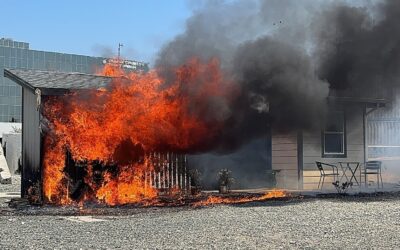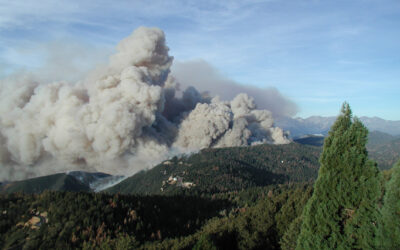Pasadena Fire Chief Chad Augustin’s plan for the city’s fire department will alleviate short-staffing issues the department experienced during the Eaton fire, he said this week.
But for that and other post-disaster longterm enhancements to his department, he’s going to need tens of millions of dollars over the next several years, he said.
Augustin proposed a 10-year plan for the department to the City Council on Monday night, including adding another battalion chief, more engines and ambulances and rebuilding two fire stations, and a budget increase, informed by the department’s experiences during the Eaton fire.
Such a plan, he said, would position the department to serve the city best over the next 25 to 50 years.
“All of our chiefs were working, yet there was just not enough to track where all of our resources were,” he told the Council during a budget discussion. “One of my biggest takeaways from this fire was that we did not have enough chief officers for your city,” Augustin said.
Augustin said he wants to ensure that lessons learned from the historically mammoth fire are applied for any future disasters.
Chad Augustin, the fire chief of the city of Pasadena, presents updates from city staff at a Pasadena City Council meeting on Monday, June 9, 2025. (Photo Courtesy of Pasadena City Council Livestream)
“Post Eaton fire, I was asked numerous times if the fire department has the resources that it needs to serve our community as well as to come back with a long-term plan, not just addressing today’s needs, but the needs of the future…” Augustin said.
The budget for the 2026 fiscal year proposed by the department reflects an overall 10% increase. Within the $7.35 million increase, $5.36 million is for personnel increases, $700,000 in increases in services and supplies utilized by the department and $1.28 million in internal services, which includes fleet maintenance, apparatus replacement and accounts for higher fuel costs.
This would bring the department’s total budget to over $76.98 million for the 2026 fiscal year, if approved by the City Council.
Augustin said that starting in the late fall last year, he began conversations with Pasadena’s city manager about adding another fire battalion chief to the department beginning in the third quarter of the 2026 fiscal year. Adding this position will help the fire department achieve its standards of coverage and the necessity of having another person in this position became clear during the Eaton fire response.
“Due to the large response area of the entire city of Pasadena, our response times are too long for one battalion chief,” Augustin said.
Adding another battalion chief was a top recommendation from a consultant the department worked with, Augustin added.
Special events being held in the area, such as the FIFA Club World Cup, which will hold matches at the Rose Bowl and the Olympics being held in L.A. in 2028, will make a second battalion chief even more important for fans visiting and Pasadena residents alike, Augustin said.
“All of these were reasons to add a second battalion chief – and then the Eaton fire happened,” Augustin said.
Keeping in mind long-term goals, along with City Manager Miguel Márquez, Augustin and the department have been working to develop a 10-year plan.
“I recognize that this plan could be incredibly expensive and we may need to look to the voters for assistance in providing funding,” Augustin said.
One to two years into the plan, the department seeks to add the second battalion chief. Two to five years in, the department’s plan includes adding a ninth engine, a seventh rescue ambulance and to rebuild Fire Station 33 on North Lake Avenue. Five to ten years in, the plan outlines adding a ninth fire station, eighth rescue ambulance, third ladder truck and rebuilding Fire Station 37 on East Foothill Boulevard.
A slide presented by Fire Chief Chad Augustin at a June 9, 2025 Pasadena City Council meeting shows the a potential ten year plan.
District 2 Councilmember Rick Cole noted that he would like to see immediate changes and investments made in emergency and fire management, given the unpredictability of disaster.
“I personally would like to see a serious effort at examining whether now is the time to invest in our fire protection and emergency response, … he said.
Augustin also mentioned that these milestones, particularly constructing new fire stations, can take a long time to achieve. He clarified that the department’s hope is to have a fleshed out plan in the next year or two, with a way to pay for the plan.
“I think waiting five to 10 years is not something we want to do,” Mayor Victor Gordo said.
What went well during the Eaton fire response?
Augustin on Monday also recapped his department’s Eaton fire response, starting with the development of Pasadena’s first evacuation plan, which began in 2022.
“It’s important to highlight that so many of the things that went well in the initial hours of the Eaton fire came from work that started multiple years earlier by your city staff,” he said.
Augustin noted that all city staff can be mobilized for disaster work during an emergency, to do work outside of the scope of the role that they were hired for, which happened during the Eaton fire.
Augustin commended Pasadena police, fire and other workers for assisting with evacuating residents who live in skilled nursing facilities in the Eaton fire footprint, many of whom are elderly or have elevated medical needs. But he also noted that there is room for improvement in disaster readiness for these facilities.
“… Many city services were dedicated to safely protect, evacuate and care for our most fragile community and they did a dang good job doing it and they saved a lot of lives,” Augustin said. “But it took away from the necessary firefighting and other community evacuations.”
In the aftermath of the Eaton fire, concerns about senior citizens and those in nursing homes rose after it was reported that many of the people who died in the fire were older adults.
Manuel Carmona, Pasadena’s director of public health, spoke about the work his agency did during the fire and aftermath, from managing infections at the evacuation center, supporting physical and social health of residents and deploying air sensors to monitor air quality after the fire.
Greg de Vinck of Pasadena Public Works recapped his agency’s response, beginning with working to clear trees that came down as winds began, and then dealing with mudflow in areas like Upper Hastings Ranch as rain pelted the area in the weeks after the disaster.
Assistant City Attorney Danielle St. Clair that areas to improve on include training more staff on emergency operations center work, so that there are more employees available to allow staff to rotate and practicing scenarios. She also cited the need to improve technology by digitizing documents and records so that they can be accessed remotely in the face of disaster when staffers may need to work outside of City Jall, or damage occurs to records.
The city will also look to expand wi-fi coverage at the Rose Bowl, with strong signals in parking lots, where command centers were set up.
Officials also identified a need to more efficiently accept and distribute donations to those who need them in disasters. An overwhelming amount of donations were received by the city, spawning an unofficial donation center at the Rose Bowl. But that bloced emergency vehicles at the Bowl, which was serving as a command center.
“In those first couple days, out of the generosity of people’s hearts and out of people just feeling like they needed to do something, there was a huge influx of donations and there really wasn’t a plan in place to anticipate that, to coordinate receipt and storage of those donations, and that became an endeavor in and of itself,” St. Clair said.
The way the city gets supplies in emergency situations is also being evaluated and more staff will be trained in how to procure emergency supplies for the city.
Additional sites that could serve as shelters will also be looked at– the convention center being open as the Eaton fire began to sweep through was lucky, St. Clair says, and the city needs to identify other options in the case that there is an emergency when a convention is already staged there. An important aspect of this will be collaboration with both private sector groups and public entities, she noted.
Jessica Rivas, councilmember for District 5, noted that east of Lake Avenue evacuation orders worked well, which was not the case east of Lake Avenue, Rivas said.
Augustin said further information from the investigation into Genasys notifications will be released at the end of July. L.A. County had been working with various cities to bring the notification system to them. When the Eaton fire began, Pasadena zones were still under the final stages of review in the notification system, which is why the fire department relied on Nixle alerts, Pasadena Local Emergency Alert System (PLEAS), going door to door and using intercoms to announce evacuations.
© 2025 Pasadena Star-News, Calif.. Visit www.pasadenastarnews.com. Distributed by Tribune Content Agency, LLC.




